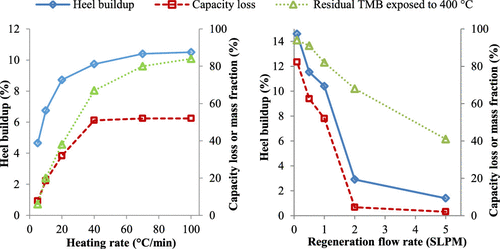当前位置:
X-MOL 学术
›
Ind. Eng. Chem. Res.
›
论文详情
Our official English website, www.x-mol.net, welcomes your
feedback! (Note: you will need to create a separate account there.)
Influence of Purge Gas Flow and Heating Rates on Volatile Organic Compound Decomposition during Regeneration of an Activated Carbon Fiber Cloth
Industrial & Engineering Chemistry Research ( IF 3.8 ) Pub Date : 2020-02-17 , DOI: 10.1021/acs.iecr.9b06070 Saeid Niknaddaf 1 , John D. Atkinson 1, 2 , Abedeh Gholidoust 1 , Mohammadreza Fayaz 1 , Rania Awad 1 , Zaher Hashisho 1 , John H. Phillips 3 , James E. Anderson 4 , Mark Nichols 4
Industrial & Engineering Chemistry Research ( IF 3.8 ) Pub Date : 2020-02-17 , DOI: 10.1021/acs.iecr.9b06070 Saeid Niknaddaf 1 , John D. Atkinson 1, 2 , Abedeh Gholidoust 1 , Mohammadreza Fayaz 1 , Rania Awad 1 , Zaher Hashisho 1 , John H. Phillips 3 , James E. Anderson 4 , Mark Nichols 4
Affiliation

|
Five-cycle adsorption/regeneration experiments using 1,2,4-trimethylbenzene (TMB) were completed at different purge gas flow and heating rates to identify their impact on heel buildup. Regeneration of a saturated activated carbon fiber cloth was completed at 400 °C using resistive heating at different heating rates and purge gas flow. At 1 standard liter per minute (SLPM) desorption purge gas, increasing the regeneration heating rate from 5 to 100 °C/min increased heel buildup from 4.6 to 10.4 wt % and adsorption capacity loss from 7.8 to 52.0%. On the other hand, at 70 °C/min heating rate, increasing the purge gas flow rate from 0.1 to 5 SLPM decreased heel buildup from 14.6 to 1.4% and capacity loss from 82.3 to 2.1%. Increasing the heating rate or decreasing the purge gas flow results in higher TMB concentrations being exposed to the high desorption temperature and higher residence time of TMB in the adsorbent pores. This increases adsorbate decomposition, causing deposition of pore-blocking, high carbon content residue (coke) onto the adsorbent surface. These results show the importance of optimizing desorption conditions to minimize heel buildup during cyclic use, contrary to conventional wisdom, suggesting that higher heating rates are consistently preferred, and provide improvements in energy use.
中文翻译:

吹扫气流和加热速率对活性炭纤维布再生过程中挥发性有机化合物分解的影响
使用1,2,4-三甲基苯(TMB)在不同的吹扫气体流量和加热速率下完成了五周期吸附/再生实验,以确定它们对跟部堆积的影响。使用电阻加热(在不同的加热速率和吹扫气流下)在400°C下完成了饱和活性炭纤维布的再生。在每分钟1标准升(SLPM)的解吸吹扫气体下,将再生加热速率从5提高到100°C / min,使脚跟堆积从4.6 wt%增加到10.4 wt%,吸附容量损失从7.8到52.0%。另一方面,在70°C / min的加热速率下,将吹扫气体流速从0.1 SLPM增加到5 SLPM,可使脚跟堆积从14.6%降低到1.4%,容量损失从82.3%降低到2.1%。增加加热速率或减少吹扫气体流量会导致较高的TMB浓度暴露于高解吸温度和较高的TMB在吸附剂孔中的停留时间。这增加了吸附物的分解,导致阻塞孔的高碳含量残留物(焦炭)沉积在吸附剂表面上。这些结果表明了优化解吸条件以最大程度地减少循环使用过程中脚跟堆积的重要性,这与传统观点相反,这表明始终优选较高的加热速率,并改善了能耗。
更新日期:2020-02-17
中文翻译:

吹扫气流和加热速率对活性炭纤维布再生过程中挥发性有机化合物分解的影响
使用1,2,4-三甲基苯(TMB)在不同的吹扫气体流量和加热速率下完成了五周期吸附/再生实验,以确定它们对跟部堆积的影响。使用电阻加热(在不同的加热速率和吹扫气流下)在400°C下完成了饱和活性炭纤维布的再生。在每分钟1标准升(SLPM)的解吸吹扫气体下,将再生加热速率从5提高到100°C / min,使脚跟堆积从4.6 wt%增加到10.4 wt%,吸附容量损失从7.8到52.0%。另一方面,在70°C / min的加热速率下,将吹扫气体流速从0.1 SLPM增加到5 SLPM,可使脚跟堆积从14.6%降低到1.4%,容量损失从82.3%降低到2.1%。增加加热速率或减少吹扫气体流量会导致较高的TMB浓度暴露于高解吸温度和较高的TMB在吸附剂孔中的停留时间。这增加了吸附物的分解,导致阻塞孔的高碳含量残留物(焦炭)沉积在吸附剂表面上。这些结果表明了优化解吸条件以最大程度地减少循环使用过程中脚跟堆积的重要性,这与传统观点相反,这表明始终优选较高的加热速率,并改善了能耗。











































 京公网安备 11010802027423号
京公网安备 11010802027423号